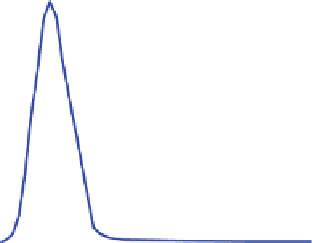Biomedical Engineering Reference
In-Depth Information
Fig. 8.4
The normalized
lifetime of the adhesion
cluster as a function of the
cluster size
N
t
for different
values of: (
a
) the reduced
elastic modulus
E
, and (
b
)
the rebinding rate
g
a
E*=10kPa
E*=20kPa
E*=25kPa
1000
800
600
400
F/(2ab)=0.5 kPa, γ=10, b=32 nm
200
ξ=0.25 pN/nm, F
b
=4 pN
0
0
20
40
60
80
100
b
2a/b (N
t
)
400
γ=50
350
γ=80
γ=100
300
250
200
150
100
F/(2ab)=0.46 kPa, E*=10 kPa, b=32 nm
50
ξ=0.25 pN/nm, F
b
=4 pN
0
0
20
40
60
80
100
2a/b (N
t
)
clusters between elastic media because stochastic effects are expected to dominate
at small scales and crack-like failure dominates at large scales. Increasing adhesion
size or decreasing material modulus tends to increase
a
toward the regime of crack-
like stress concentration, hence reducing the lifetime and stability of adhesion.
8.5.3 Critical Bond Spacing for Stable Adhesion
An interesting phenomenon on receptor-independent adhesion has been reported by
Spatz and co-workers [
61
,
62
]. They showed that stable FAs on substrates prepared
with precisely controlled ligand distribution can be formed only if the ligand
spacing is below 58 nm and no adhesion is possible for ligand spacing above
73 nm, and that these critical spacings seem to be insensitive to cell types [
61
].
A feasible explanation of this phenomenon has been provided by Lin et al. [
63
]by
considering the competition between thermal fluctuations of cell membranes and
ligand-receptor binding. However, as it has been experimentally confirmed that cell










































































































Search WWH ::

Custom Search